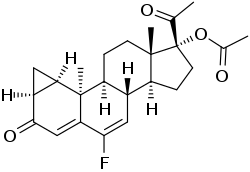DU-41164
DU-41164, also known as 1,2β-methylene-6-fluoro-17α-acetoxy-δ6-retroprogesterone, is a progestin which was developed by Philips-Duphar in the 1970s and was never marketed.[1][2][3][4][5] It is a combined derivative of 17α-hydroxyprogesterone and retroprogesterone.[1][2][3][4] The drug shows extremely high potency as a progestogen in animals; it was reported to possess 500 times the affinity of progesterone for the progesterone receptor expressed in rabbit uterus (Ki = 0.87 pM and 0.41 nM, respectively), and showed 600 times the progestogenic potency of subcutaneous progesterone when given orally in animals.[1][2] The affinity of DU-41164 for the progesterone receptor was described in 1974 as "probably the highest reported for any steroid-receptor interaction".[2] The drug showed no androgenic, anabolic, antiandrogenic, estrogenic, or corticosteroid activity in animals.[3] Although highly potent in animals, DU-41164 produced little or no progestogenic effect at dosages of 50 and 200 µg/day in women, suggesting major species differences.[3] A closely related compound, DU-41165, has been developed as a photoaffinity label for the progesterone receptor.[3]
 | |
| Clinical data | |
|---|---|
| Other names | 1,2β-Methylene-6-fluoro-17α-acetoxy-δ6-retroprogesterone; 6-Fluoro-17α-hydroxy-1,2β-methylene-9β,10α-pregna-4,6-diene-3,20-dione 17α-acetate; 6-Fluoro-1,2β-methylene-3,20-dioxo-9β,10α-pregna-4,6-dien-17α-yl acetate; (1α,2α,9β,10α)-17-Acetoxy-6-fluoro-1,2-dihydro-3'H-cyclopropa[1,2]pregna-1,4,6-triene-3,20-dione |
| Routes of administration | By mouth |
| Drug class | Progestin; Progestogen |
| Identifiers | |
IUPAC name
| |
| CAS Number | |
| PubChem CID | |
| ChemSpider | |
| Chemical and physical data | |
| Formula | C24H29FO4 |
| Molar mass | 400.49 g/mol g·mol−1 |
| 3D model (JSmol) | |
SMILES
| |
InChI
| |
References
- Halkes SJ, Hartog J, Morsink L, de Wachter AM (December 1972). "Investigations on sterols. 38. Synthesis of 1,2β-methylene-17α-acetoxy-9β,10α-pregnanes, a class of potent progestational agents". J. Med. Chem. 15 (12): 1288–92. doi:10.1021/jm00282a022. PMID 4635976.
- Terenius L (June 1974). "Affinities of progestogen and estrogen receptors in rabbit uterus for synthetic progestogens". Steroids. 23 (6): 90919. doi:10.1016/0039-128X(74)90063-4. PMID 4134774.
- Morsink L, de Wachter AM, Brenner P, Cekan SZ, Guerrero R, Hagenfeldt K, Diczfalusy E (May 1976). "Endocrine effects of two new retro-steroids in animal models and in women". Acta Endocrinol. 82 (1): 193–212. doi:10.1530/acta.0.0820193. PMID 57688.
- Pinney KG, Carlson KE, Katzenellenbogen JA (February 1990). "[3H]DU41165: a high affinity ligand and novel photoaffinity labeling reagent for the progesterone receptor". J. Steroid Biochem. 35 (2): 179–89. doi:10.1016/0022-4731(90)90272-T. PMID 2308335.
- AdrainD. Nunn (27 April 2018). Radiopharmaceuticals: Chemistry and Pharmacology. CRC Press. pp. 1–. ISBN 978-1-351-41989-5.